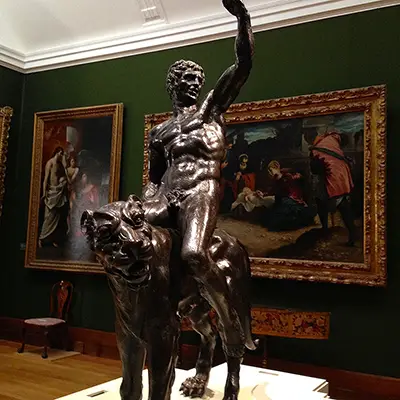The bronzes themselves have been attributed to Michelangelo as recently as 2015, meaning this discussion is still very much alive. That occurred whilst they were out on display at the Fitzwilliam Museum, University of Cambridge for a number of months and this respected institution would not have made this claim without a genuine amount of research to back that up. The bronzes feature much the same poses, but with the two figures varying considerably in age. Those who have put Michelangelo forward as the creator would place these pieces at about 1506-1508 but the sculptor normally used marble rather than bronze, making it harder to compare them with other items from his career, which would have placed it before his fresco work for the Sistine Chapel ceiling, but after his iconic statue of David. The two figures within each statuette are riding unknown mythological creatures which most resemble panthers.
In 1877 Baron Adolphe de Rothschild and Julie de Rothschild had purchased the two statues and then exhibited them a year later at the Paris Exposition Universellein, advertising them as being from the hand of Michelangelo. This explains why they are known as the Rothschild Bronzes but after the couple and their immediate heir passed away they were then purchased by a French collector in the 1950s. Since then they have many other names linked to them, such as Tiziano Aspetti and Benvenuto Cellini, as well as more generally a part of their respective circles. They were then sold again as recently as 2002 for £1.8m which can be considered both a high or low valuation, depending on who the original creator actually was. There will always be an interest for any owner to connect items to someone like Michelangelo, because of the increased valuation that this would bring, but with every year there seems a new sculptor linked to them from one source or another.
As mentioned, the double sculpture was featured at the Fitzwilliam Museum for a period of months and also underwent a series of tests in order to better understand its background. Many saw similarities in terms of the anatomical design with other items from Michelangelo's career. A publication was released too, which paid attention to the master's work with bronze and it featured the Rothschild Bronzes within that. The main arguments in favour of it being a genuine Michelangelo sculpture were that there is an existing drawing that he produced which bears clear similarities to the sculptures, plus also the accurate dating which would fit in line with the master's career. Those points, added to the similarity in design with other marble sculptures by Michelangelo was enough for them to come to the conclusions that they did.



